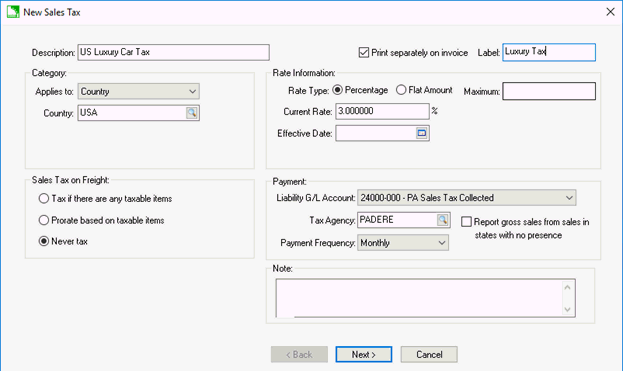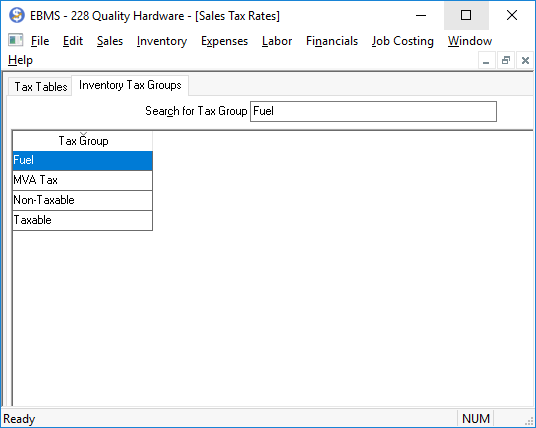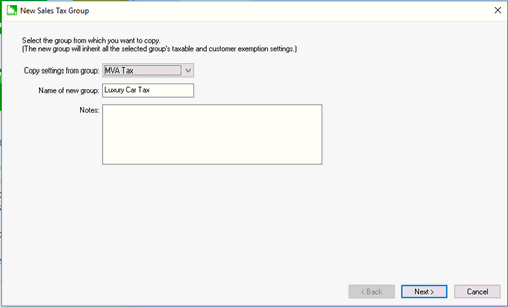Luxury, VAT, and Sales Tax Minimums and Maximums
The advanced sales tax module is required to calculate the following sales tax rates. This optional module allows the user to create sales tax groups. Contact your Koble Systems representative to add this module to your EBMS subscription. Review the Inventory Tax Groups section for more details.
US States with Multiple Tax Rates
Some states require additional sales taxes for a specific group of products. For example, the state of Virginia could have a sales tax rate of 5% for non-food items (4% is state and 1% is county). An additional 2.5% is levied for food items. Prepared food requires an additional 4% for a total of 11.5%.
The Virginia configuration described above would require the following five sales tax records:
-
Base State Tax of 4% with the category settings of Applies to state.
-
Base County Tax of 1% with the category setting of Applies to county.
-
State tax for food of 1.5% with the category setting of Applies to state.
-
County tax for food of 1% with the category setting of Applies to county.
-
Local tax for processed foods of 4% with a category setting of Applies to county.
Review Establishing Sales Tax Rates for more details.
An alternative method to calculate sales tax including luxury and VAT taxes is the cloud TaxJar sales tax subscription. Review TaxJar Overview for details.
Since rates are determined by inventory items, the following tax groups must be created:
- Non-food items are taxed using records 1 - 2 listed above for a total rate of 5%.
- Food items are taxed using records 1 - 4 listed above for a total rate of 7.5%.
- Prepared food items are taxed using all five records for a total rate of 11.5%.
Review the Inventory Tax Groups section for more details on creating these tax groups.
Canadian PST and GST Tax
Canadian provinces that collect GST and PST tax (rather than a combined HST) require the optional advanced sales tax module. For example, in the province of Manitoba, service labor and fuel are exempt from GST tax. Tax groups should be created for each non-taxable product group.
Create a tax record for both GST and PST tax. Review Establishing Tax Rates for more details.
Create an inventory tax group for each group that is taxed differently by these two sales taxes. Review the Inventory Tax Groups section for more details.
Luxury Tax
A luxury tax charges a sales tax percentage for specific products such as expensive cars or jewelry. Certain luxury taxes charge luxury tax for items over a determined limit. Any luxury tax with a minimum or maximum requires the optional advanced sales tax module.
Complete the following steps to set up a luxury tax:
Create a tax record for the luxury tax as shown below.
Select Sales > Sales Tax > Rates > Tax Tables tab from the main EBMS menu to open the sales tax rate list. Click the New button to launch the New Sales Tax wizard as shown above. Review Establishing Tax Rates for more details on creating new tax rates.
Create an Inventory Tax Group to identify all the luxury items that are taxable by completing the following steps:
-
-
Click on the Inventory Tax Groups tab on Sales > Sales Tax > Rates as shown below:

-
Click the New button to launch the following new sales tax group wizard:

-
Click Next to open the tax rate list as shown below:

-
Select the 3rd option (This group's taxable settings vary for taxes in the selected folder) as shown above. Review the Inventory Tax Groups section for more details on these options.
-
Enable the Taxable option for the Luxury Tax rate as shown above and enter the minimum price amount into the Price Greater Than column so that the tax only applies to luxury products that exceed a set cost.
-
Click OK to save the Inventory Tax Group settings. Review the Inventory Tax Groups section for more details on these settings.
-
Click on the Inventory Items tab to view the items that are within the current Inventory Tax Group. Items cannot be added within this tab. A product’s Tax Group must be set within the inventory item’s General tab. Review the Changing Product Information section of the Inventory documentation for more details on changing product information, including the tax group.
Review Establishing Tax Rates for more details.
Value Added Tax
Value added tax is a form of consumption tax that is a tax only on the value added to the product or service. Create an inventory tax group if the value added tax applies to a specific group of products. Create a value added tax record. Review Establishing Sales Tax Rates for more details.